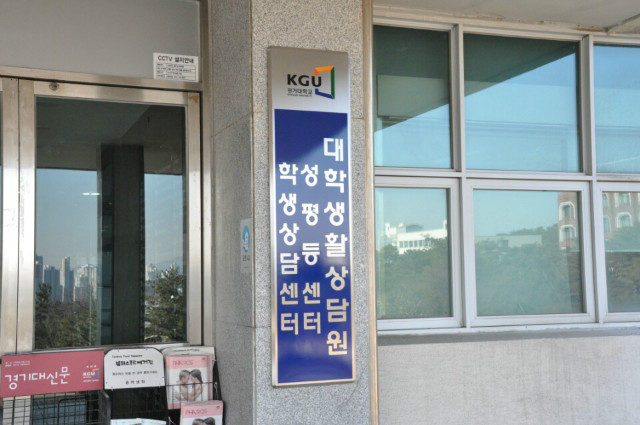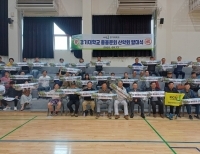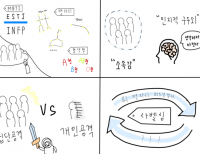
Are You Safe from Sexual Harassment?
A news article reported that Y University posted a handwritten notice about sexual harassment by male students on November 16, 2016. According to the notice, male students told dirty jokes and even suggested committing sexual assault in Kakao Talk. Also, same-sex sexual harassment occurred in 2016 and K and S Universities became the subject of sexual harassment incidents occurring in chat rooms. At one of these two universities, K University, the sexual harassment problem happened on Facebook. So, direct as well as indirect sexual harassment cases can be found easily. Kyonggi University was strongly stirred up by cases of sexual harassment just a few months ago. The problem received attention when one student remarked about one of College of Social Sciences professor who has used a word related to sexual harassment in his lectures for about 10 years. He is infamous to students who major in College of Social Sciences. Most students are aware of this professor's problem, but a student's courage exposed the problem recently. Sexual harassment is no longer unimportant to us and we are aware it takes place around us. Therefore, people understand they also may be the target of sexual harassment.
The easy target can be a freshman. Because the freshman's campus experience is limited he or she might panic and not know what to do when sexual harassment occur. So they aren't likely to make an appropriate response. Thus, the news usually has a lot of sexual harassment articles about freshmen in March because a lot of freshmen activities are held at that time. For example, a university in Daejeon wrote a statement concerning sexual humiliation that occurred while fresh-men were playing an MT game in March last year. In addition, it is known that there was a highly controversial case of sex-ual harassment during the orientation of freshmen in K University. Some students organized an event that included sexual assault and sexual harassment against freshmen at the university.
Is our school a safe place with regard to sexual harassment? To answer this question we conducted a survey of students at the university and looked at the facts of sexual harassment in our school.
According to a survey of 125 Kyonggi University students, 69 percent of them believe sexual harassment occurs on cam-pus. Although there has been no prominent incident aside from the recent one involving a professor in the major of international relations, a majority of students believe sexual harassment happens at Kyonggi University. Even more concerning, 23 percent of students reported that they have suffered from direct or indirect sexual harassment.

In a survey question on the spot where sexual harassment occurred, the most frequent response was the entire cam-pus such as a street or playground, and it was selected by 22 percent of respondents. Personal Kakao Talk was the second most common response with 19 percent of responses. This means that students have often suffered from sexual harassment directly. In addition with regard to the perpetrators of sexual harassment, friends and seniors was the answer given by 71 percent of people while the next most common response at 13 percent was professors. This survey shows that there are many people who have suffered from sexual harassment, so it cannot be ignored in our school. Plus, the results show that it is the people who we usually meet that assault us.

So what exactly is sexual harassment? Fortunately, because most Kyonggi University students have had sex education, they are aware of the difference between sexual harassment and sexual assault. As many as 91 percent of people said they were aware of the difference between sexual harassment and sexual assault. But even knowing the terms are different, they might not recognize specific performance differences. Also, there are many related words like sexual violence, sexual bullying and so on in addition to sexual harassment and sexual assault. Therefore, the Pharos will review the differences. Sexual violence covers all the concepts regarding sex such as sexual harassment and sexual assault, and it means a harmful act against another party. The sexual harassment contained in the concept of sexual violence is language or behavior in a physical, verbal or visual act that provokes sexual humiliation or disgust. For example, physical contact like a kiss, cuddle or hug from behind are included. And there are many other actions such as touching a specific body part, massaging or imposing a caress. In the case of verbal acts, indecent talk and lewd or obscene jokes are also considered sexual harassment, and when they that are made through phone calls they are also included. Also included are sexual metaphors, the assessment of appearance, intentionally spreading information of a sexual nature and forced sexual relations. In the case of visual acts, prohibited activities include posting obscene pictures, paintings, graffiti and publications, and showing or exposing specific body parts deliberately.
Sexual assault, another of the kinds of sexual violence, means sexual abuse. It is not rape but does include physical contact that causes sexual humiliation. The sexually violent act of rape is recognized under criminal law. In other words, the biggest difference between sexual harassment and sexual assault is the existence of indecent physical contact during sexual assault, and sexual assault is accompanied by violence and threats. Sexual harassment is not subject to a criminal penalty if an act does not correspond to the Special Act on illicit sexual behavior, but perpetrators of sexual assault can receive a criminal penalty because it is defined as an indecent assault in the law. However, minor contact, which might not amount to sexual assault, can be a weak form of sexual harassment. Therefore, there is some overlap between the concepts of sexual harassment and sexual assault, but if there's physical contact, sexual harassment is commonly dealt with as sexual assault and criminal charges are possible. Therefore, if there is a sexual word or action involving an offensive sexual physical contact like threats or violence, the perpetrator can be charged under Article 298 of the criminal code and a prison term or prison labor of less than 10 years or a fine of not more than 15 million won can be imposed. In the case of sexual harassment, criminal accusation is not possible, and just a claim for damages can be made.
For example, when a professor keeps touching a girl's hand or knee, or a male senior touches or hugs a girl's body using the excuse of being drunk, these are cases of sexual harassment. Also, when seniors select stimulating and sexually pro-vocative material to induce students' participation in an event, it can be a case of sexual harassment if students feel dis-pleased. A man masquerading as a female during a freshman orientation program is an example for this. Such a program in which a man has large balloons representing breasts and is wearing a short skirt may be intended to be funny, but the sexual expression can cause female students to feel displeasure.
Then, what should we do to make a crime-free society? Of course, the ideal would be the nonexistence of perpetrators. However, this is no more than just an ideal. Instead, we must prevent sex crimes by conducting sexual crime prevention education at the national level so that we can get closer to this ideal. Another solution would be to prevent it from recur-ring by punishing the person who committed the crime or providing the person with rehabilitative care. Such measures are currently being discussed. However, at this time the punishment in Korea is so weak compared to other countries that it is even called "cotton batting" punishment. However, since the degree of punishment is determined by law and judges, it is left to them and we must make changes. Given this, what can we do to cope with sexual harassment at the present time?
We found out sexual harassment is happening at the college through the preceding survey. What should you do if it happens to you? First, if someone attempts sexual harassment, you must clearly state your intention of refusal. In addition, you should record the exact time, place, and method of the harassment, and keep any messages from the perpetrator and a call history of the person's phone calls. If such evidence is secured, the countermeasures are as follows.
After suffering from sexual violence, such as sexual harassment and sexual assault, the situation needs to be recognized. For example, you should identify what your feelings about the event are, what impact the event has on your daily life, what the trauma or inner damage is, and whether someone else is going to hurt or criticize you again. If the situation is grasped in general, the victim can cope in three major ways.
First, if you want to get outside help, you can visit the Sexual Violence Relief Center. Typically, there is a "Sunflower Center." It is an organization created for the counseling and support of victims of sexual violence, domestic violence and prostitution, and is attached to local hospitals in small and medium-sized or bigger cities nationwide. The victims are counseled 24 hours a day, 365 days a year and provided with psychological care, case support, medical care, and an investigation to prevent injuries. Kyonggi University also has a sexual harassment prevention center for students called the Gender Equality Center. If the center receives report of sexual harassment, they convene an investigation committee. This committee investigates and deliberates the case and issues disciplinary action against the perpetrator. When the victim wants the case to be informal, the case is concluded with a personal apology from the perpetrator and an agreement. In addition, students can apply for sexual violence counseling through the website of the sexual harassment prevention center. Then the victim is provided with medium and long-term counseling services for the healing and recovery of the aftermath of the sexual assault, and the perpetrator is provided with education so as to prevent a recurrence by reflecting on the person's distorted sexual attitudes and behavior. Moreover, the Gender Equality Center provides education every semester to prevent sexual violence and provides a sexual harassment prevention booklet which is guidance on proper sexual attitudes and the handling of sexual violence. You can also receive personal counseling provided by the Student Life Counseling Center at Kyonggi University. Individual counseling is conducted 50 minutes at a time, and counseling can be continued every week if you want. Counseling is free and consultation contents are kept confidential.
The second way is to face the perpetrator in person. Consider the monetary compensation or apology you will demand from the perpetrator before meeting, and record all the conversation. In the case of sexual violence, it is not easy to obtain evidence or witnesses. Therefore, it is important to record the acknowledgment of the assault and the explanation given at the time of the encounter with the abuser. If you agree with the perpetrator not to take civil or criminal action, write down an agreement of your and the perpetrator's personal details, specific facts of damages incurred according to five W’s and one H, the victim's requirements, action for non-compliance to requirements, and the date.
Third, there is legal action. There are two types of legal action, civil action and criminal action. A civil action is to claim monetary compensation that is awarded by a court to an individual who has been injured or whose property has been damaged by some actions such as sex crimes. In this case, the victim becomes the plaintiff and claims damages from the perpetrator (the defendant) so both the victim and the perpetrator are the main agents of the suit. Therefore, the victim must prove he or she has been injured by appointing a litigation representative. A criminal action is to punish the perpetrator by suing and investigating to prepare for a trial. In the process of a criminal action, you can bring an accusation against the perpetrator. Through an investigation stage involving the police and prosecutors, punishment of the perpetrator is demanded of the court. At this time, the victim will testify as a witness rather than as a main agent of the suit. The prosecutor will demand a penalty for the perpetrator by disclosing the crime, and if the perpetrator is found guilty, he/she will be punished. Civil and criminal actions are conducted at the same time, and you can resolve one even if the other is ongoing. In addition, a civil action can proceed even if a non-prosecution disposition or a sentence of being not guilty is given in a criminal action. Currently, a forced indecent act is punished by imprisonment of less than 10 years or a fine not exceeding 15 million won under Article 298 of the Criminal Law. In the case of a legal action, time and economic burden is required until the case is resolved so the victim may be mentally fatigued.
We have discussed three measures that can be taken against sexual harassment and sexual assault. As mentioned earlier, it is a matter of course to believe that sexual crime should be eliminated, but it has been steadily continuing and will continue to do so, unfortunately. Therefore, we must make efforts to reduce it. An important part of this is the active response of the victims. Of course, this is not easy because of the physical and psychological trauma associated with sexual harassment. According to the survey, sexual harassment and sexual assault cases reported to the police are increasing. One of the reasons for this is that the sexual harassment rate has increased. However, more than that, people are more aware of sexual harassment than in the past. Sexual harassment was rampant as well in the past, but victims hid the injury they experienced because they were worried about other’s seeing them in a negative light; but now victims are responding actively. This active response can prevent secondary injury. In addition, personal and social perceptions of these victims should be improved so that we do not see them in a negative light or frame them as "sex crime victims." If you have any victims around you, why don’t you try to make a better society by actively taking action against the crime together?
 Freedom Given to Youth: An Opportunity for Choice or a Burden of Constraint?
“Are we truly free today?” Classical literature is far more than time-honored stories. It offers profound insights into human nature and society that transcend time, remaining a valuable resource for examining the challenges our world faces today. This article will draw on George Orwell’s 1984 and Charles Dickens’ Oliver Twist to explore the contemporary issues of youth housing and the emergence of a surveillance society ...
Freedom Given to Youth: An Opportunity for Choice or a Burden of Constraint?
“Are we truly free today?” Classical literature is far more than time-honored stories. It offers profound insights into human nature and society that transcend time, remaining a valuable resource for examining the challenges our world faces today. This article will draw on George Orwell’s 1984 and Charles Dickens’ Oliver Twist to explore the contemporary issues of youth housing and the emergence of a surveillance society ...

 [단신] 산악회, 본교 동문의 버팀목이 될 수 있도록
[단신] 산악회, 본교 동문의 버팀목이 될 수 있도록
 [사회메인] 노인 인구 1,000만 시대, 준비 없는 사회가 불안해
[사회메인] 노인 인구 1,000만 시대, 준비 없는 사회가 불안해
 [네컷만화] 라벨링 문화
[네컷만화] 라벨링 문화
 [진리터] 결국 우리 모두 돌아볼 것이니
[진리터] 결국 우리 모두 돌아볼 것이니

 목록
목록














